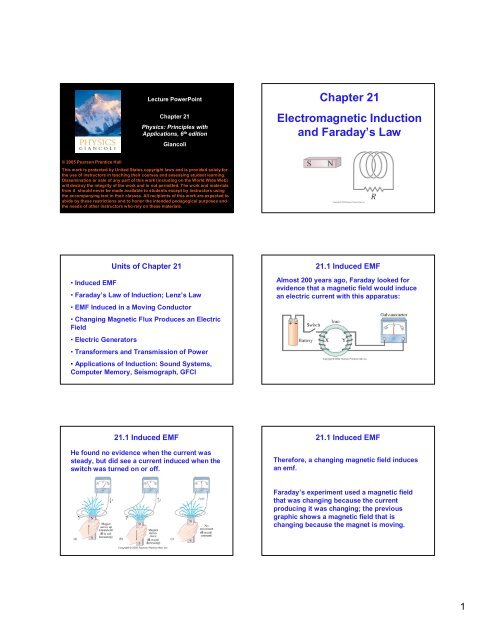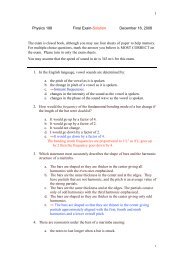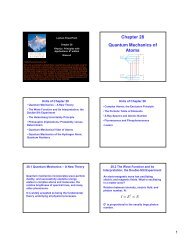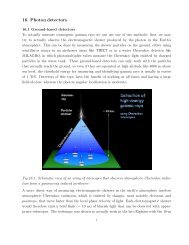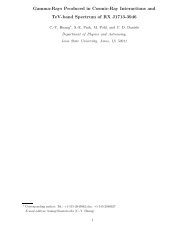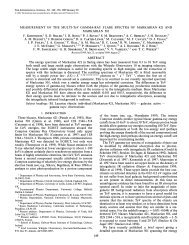Chapter 21 Electromagnetic Induction and Faraday's Law
Chapter 21 Electromagnetic Induction and Faraday's Law
Chapter 21 Electromagnetic Induction and Faraday's Law
Create successful ePaper yourself
Turn your PDF publications into a flip-book with our unique Google optimized e-Paper software.
Lecture PowerPoint<br />
<strong>Chapter</strong> <strong>21</strong><br />
Physics: Principles with<br />
Applications, 6 th edition<br />
Giancoli<br />
<strong>Chapter</strong> <strong>21</strong><br />
<strong>Electromagnetic</strong> <strong>Induction</strong><br />
<strong>and</strong> Faraday’s <strong>Law</strong><br />
© 2005 Pearson Prentice Hall<br />
This work is protected by United States copyright laws <strong>and</strong> is provided solely for<br />
the use of instructors in teaching their courses <strong>and</strong> assessing student learning.<br />
Dissemination or sale of any part of this work (including on the World Wide Web)<br />
will destroy the integrity of the work <strong>and</strong> is not permitted. The work <strong>and</strong> materials<br />
from it should never be made available to students except by instructors using<br />
the accompanying text in their classes. All recipients of this work are expected to<br />
abide by these restrictions <strong>and</strong> to honor the intended pedagogical purposes <strong>and</strong><br />
the needs of other instructors who rely on these materials.<br />
• Induced EMF<br />
Units of <strong>Chapter</strong> <strong>21</strong><br />
• Faraday’s <strong>Law</strong> of <strong>Induction</strong>; Lenz’s <strong>Law</strong><br />
• EMF Induced in a Moving Conductor<br />
• Changing Magnetic Flux Produces an Electric<br />
Field<br />
• Electric Generators<br />
• Transformers <strong>and</strong> Transmission of Power<br />
• Applications of <strong>Induction</strong>: Sound Systems,<br />
Computer Memory, Seismograph, GFCI<br />
<strong>21</strong>.1 Induced EMF<br />
Almost 200 years ago, Faraday looked for<br />
evidence that a magnetic field would induce<br />
an electric current with this apparatus:<br />
<strong>21</strong>.1 Induced EMF<br />
He found no evidence when the current was<br />
steady, but did see a current induced when the<br />
switch was turned on or off.<br />
<strong>21</strong>.1 Induced EMF<br />
Therefore, a changing magnetic field induces<br />
an emf.<br />
Faraday’s experiment used a magnetic field<br />
that was changing because the current<br />
producing it was changing; the previous<br />
graphic shows a magnetic field that is<br />
changing because the magnet is moving.<br />
1
<strong>21</strong>.2 Faraday’s <strong>Law</strong> of <strong>Induction</strong>;<br />
Lenz’s <strong>Law</strong><br />
<strong>21</strong>.2 Faraday’s <strong>Law</strong> of <strong>Induction</strong>;<br />
Lenz’s <strong>Law</strong><br />
The induced emf in a wire loop is proportional<br />
This drawing shows the variables in the flux<br />
to the rate of change of magnetic flux through<br />
equation:<br />
the loop of cross-sectional area A.<br />
Magnetic flux: (<strong>21</strong>-1)<br />
Unit of magnetic flux: weber, Wb.<br />
1 Wb = 1 T·m 2<br />
<strong>21</strong>.2 Faraday’s <strong>Law</strong> of <strong>Induction</strong>;<br />
Lenz’s <strong>Law</strong><br />
The magnetic flux is analogous to the electric<br />
flux – it is proportional to the total number of<br />
lines passing through the loop.<br />
<strong>21</strong>.2 Faraday’s <strong>Law</strong> of <strong>Induction</strong>;<br />
Lenz’s <strong>Law</strong><br />
Faraday’s law of induction:<br />
[1 loop] (<strong>21</strong>-2a)<br />
[N loops] (<strong>21</strong>-2b)<br />
<strong>21</strong>.2 Faraday’s <strong>Law</strong> of <strong>Induction</strong>;<br />
Lenz’s <strong>Law</strong><br />
<strong>21</strong>.2 Faraday’s <strong>Law</strong> of <strong>Induction</strong>;<br />
Lenz’s <strong>Law</strong><br />
The minus sign gives the direction of the<br />
induced emf:<br />
A current produced by an induced emf moves in<br />
a direction so that the magnetic field it<br />
produces tends to restore the changed field.<br />
Magnetic flux will change if the area of the<br />
loop changes:<br />
This rule is known as Lenz’s law.<br />
2
<strong>21</strong>.2 Faraday’s <strong>Law</strong> of <strong>Induction</strong>;<br />
Lenz’s <strong>Law</strong><br />
Magnetic flux will change if the angle between<br />
the loop <strong>and</strong> the field changes:<br />
<strong>21</strong>.2 Faraday’s <strong>Law</strong> of <strong>Induction</strong>;<br />
Lenz’s <strong>Law</strong><br />
Problem Solving: Lenz’s <strong>Law</strong><br />
1. Determine whether the magnetic flux is increasing,<br />
decreasing, or unchanged.<br />
2. The magnetic field due to the induced current points in<br />
the opposite direction to the original field if the flux is<br />
increasing; in the same direction if it is decreasing; <strong>and</strong><br />
is zero if the flux is not changing.<br />
3. Use the right-h<strong>and</strong> rule to determine the direction of the<br />
current.<br />
4. Remember that the external field <strong>and</strong> the field due to the<br />
induced current are different.<br />
<strong>21</strong>.2 Faraday’s <strong>Law</strong> of <strong>Induction</strong>;<br />
Lenz’s <strong>Law</strong><br />
<strong>21</strong>.3 EMF Induced in a Moving Conductor<br />
This image shows another way the magnetic<br />
flux can change:<br />
<strong>21</strong>.3 EMF Induced in a Moving Conductor<br />
The induced emf is<br />
<strong>21</strong>.4 Changing Magnetic Flux Produces an<br />
Electric Field<br />
-<br />
Blood contains<br />
Ions!<br />
(<strong>21</strong>-3)<br />
A changing magnetic flux induces an electric<br />
field; this is a generalization of Faraday’s<br />
law. The electric field will exist regardless of<br />
whether there are any conductors around.<br />
Measurement of<br />
blood velocity from<br />
induced emf:<br />
3
<strong>21</strong>.5 Electric Generators<br />
A generator is the opposite of a motor – it<br />
transforms mechanical energy into electrical<br />
energy. This is an ac generator:<br />
The axle is rotated by an<br />
external force such as<br />
falling water or steam.<br />
The brushes are in<br />
constant electrical<br />
contact with the slip<br />
rings.<br />
<strong>21</strong>.5 Electric Generators<br />
A dc generator is<br />
similar, except that it<br />
has a split-ring<br />
commutator instead of<br />
slip rings.<br />
<br />
<strong>21</strong>.5 Electric Generators<br />
=<br />
ab ⊥<br />
=<br />
2 B N l v 2 B N l v sinθ<br />
ab<br />
<strong>21</strong>.5 Electric Generators<br />
A sinusoidal emf is induced in the rotating<br />
loop (N is the number of turns, <strong>and</strong> A the area<br />
of the loop):<br />
<strong>21</strong>.7 Transformers <strong>and</strong> Transmission<br />
of Power<br />
A transformer consists of two coils, either<br />
interwoven or linked by an iron core. A<br />
changing emf in one induces an emf in the<br />
other.<br />
The ratio of the emfs is equal to the ratio of<br />
the number of turns in each coil:<br />
(<strong>21</strong>-6)<br />
<strong>21</strong>.7 Transformers <strong>and</strong> Transmission<br />
of Power<br />
This is a step-up<br />
transformer – the emf<br />
in the secondary coil<br />
is larger than the emf<br />
in the primary:<br />
Why is the iron core<br />
laminated?<br />
4
<strong>21</strong>.7 Transformers <strong>and</strong> Transmission<br />
of Power<br />
Energy must be conserved; therefore, in the<br />
absence of losses, the ratio of the currents<br />
must be the inverse of the ratio of turns:<br />
<strong>21</strong>.7 Transformers <strong>and</strong> Transmission<br />
of Power<br />
Transformers work only if the current is<br />
changing; this is one reason why electricity<br />
is transmitted as ac.<br />
(<strong>21</strong>-6)<br />
<strong>21</strong>.8 Applications of <strong>Induction</strong>: Sound<br />
Systems, Computer Memory,<br />
Seismograph, GFCI<br />
This microphone works by induction; the<br />
vibrating membrane induces an emf in the coil<br />
<strong>21</strong>.8 Applications of <strong>Induction</strong>: Sound<br />
Systems, Computer Memory,<br />
Seismograph, GFCI<br />
Differently magnetized<br />
areas on an audio tape<br />
or disk induce signals in<br />
the read/write heads.<br />
<strong>21</strong>.9 Inductance<br />
Mutual inductance: a changing current in one<br />
coil will induce a current in a second coil.<br />
(<strong>21</strong>-8a)<br />
And vice versa; note that the constant M,<br />
known as the mutual inductance, is the same:<br />
<strong>21</strong>.9 Inductance<br />
Unit of inductance: the henry, H.<br />
1 H = 1 V·s/A = 1 ·s.<br />
A transformer is an<br />
example of mutual<br />
inductance.<br />
(<strong>21</strong>-8b)<br />
5
<strong>21</strong>.9 Inductance<br />
A changing current in a coil will also induce<br />
an emf in itself:<br />
(<strong>21</strong>-9)<br />
• Magnetic flux:<br />
Summary of <strong>Chapter</strong> <strong>21</strong><br />
• Changing magnetic flux induces emf:<br />
Here, L is called the self-inductance.<br />
Eq.<strong>21</strong>-9 determines how an inductor<br />
behaves in an electric circuit.<br />
• Induced emf produces current that<br />
opposes original flux change<br />
Summary of <strong>Chapter</strong> <strong>21</strong><br />
• Changing magnetic field produces an electric<br />
field<br />
• Electric generator changes mechanical<br />
energy to electrical energy; electric motor<br />
does the opposite<br />
• Transformer uses induction to change<br />
voltage:<br />
6


